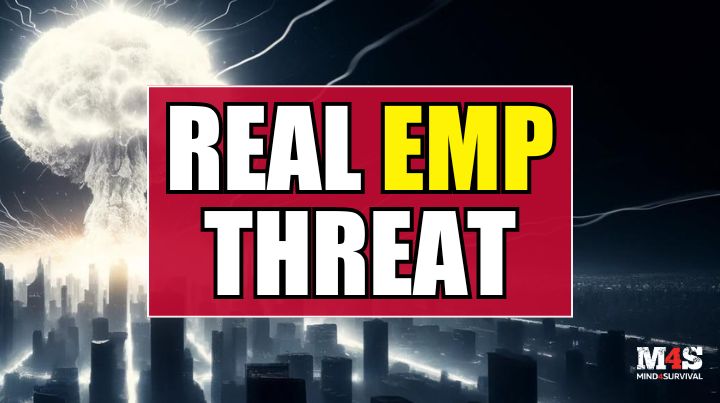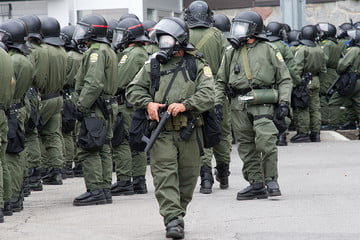How Likely Is an EMP Attack? The Reality Behind the Threat

In today’s uncertain world, the specter of an electromagnetic pulse (EMP) attack looms large. Such an event could cripple nations, devastate infrastructure, and plunge societies into darkness. But how probable is this scenario?
I asked recognized EMP expert Dr. Arthur T. Bradley to shed light on this concerning issue. As the preeminent EMP expert in the prepping community, with a rich foundation in engineering, EMP research, and a long history with NASA, Dr. Bradley offers unparalleled insights into the dangers and potential of EMP attacks. His authoritative perspective sheds light on the complexities of these threats and highlights the critical need for readiness and resilience.
Read on to learn about the realities of EMP attacks and how to build resilience to a nuclear attack.
Is There an EMP Threat to the United States?
The debate around the potential for an electromagnetic pulse (EMP) attack against the United States encapsulates a blend of technological capability, international relations, and geopolitical unpredictability. Dr. Bradley highlights the challenge in forecasting such events due to the evolving capabilities of nation-states and non-state actors. While countries like Russia and China have the nuclear arsenal and intercontinental ballistic missile technology to initiate an EMP nuclear weapon, the proliferation of knowledge and technology also opens the door for non-state entities to pose a credible threat.
The Threat is Complex
The dual-threat landscape is complex. Nation-states possess the means for a high-altitude EMP detonation, leveraging intercontinental ballistic missile (ICBM) technology. International deterrents and the mutual assured destruction doctrine somewhat mitigate this traditional threat.
However, the emergence of non-state actors with potential access to similar technologies introduces an unpredictable element. Though logistically challenging, the feasibility of a non-state orchestrating such an attack cannot be entirely discounted. As such, it raises concerns over the security of critical vulnerability in the United States’ critical infrastructure.
Preparedness is Key
Dr. Bradley’s insights underscore the importance of vigilance and preparedness in the face of these threats. The United States must continue to invest in protective measures for its critical infrastructure sectors and develop comprehensive response strategies. The unpredictable nature of EMP threats, whether from established nations or emerging non-state actors, necessitates a strong and adaptive approach to national security and resilience.
The Reality of a Successful EMP Attack?
According to Dr. Bradley, the reality of an EMP attack is not a matter of if but when. He notes that while the full-scale use of high-altitude nuclear weapons has not occurred, smaller-scale EMP weapons have been used. These weapons, capable of using electromagnetic radiation and disabling electronic systems at military installations, hint at the broader potential for disruption. Russia and China’s threat of EMP use on the United States is real.
The potential for EMP attacks extends beyond the theoretical, touching on a stark reality that could alter the fabric of modern society. The reliance on electronic systems and the electric grid across all facets of life—from healthcare and finance to transportation and communication—makes the threat of an EMP not just a matter of national security but of survival. The cascading effects of such an attack could lead to widespread chaos, affecting hundreds of millions of lives and the very functioning of society.
A Lower Barrier to Executing an EMP Attack
Additionally, the advancement of technology and the proliferation of knowledge about EMPs has lowered and continues to lower the barrier to executing an attack. With countries around the world developing and refining their nuclear capabilities, the possibility of an EMP being used as a strategic weapon in conflicts has increased.
This global dimension of the EMP threat highlights the importance of maintaining a focused effort in EMP defense strategies and promoting preparedness across society. The dialogue around EMP preparedness is not just about deterring attacks but also about ensuring that nations can recover swiftly should such an event occur, minimizing the impact on the public and the economy.
The Chinese Balloon Incident: A Pre-Run to an EMP Delivery System?
The incident involving a Chinese balloon drifting through US airspace has, justifiably, ignited concern and conjecture among the nation. Initially perceived as benign, the event quickly escalated into a national security issue, sparking debates on its true intentions.
While some argue it was merely a tool for intelligence gathering, others speculate on a more ominous purpose. They suggest it could be a dry run for deploying an electromagnetic pulse (EMP) delivery system. This theory hypothesizes that the balloon could test the waters for a more stealthy and indirect approach to compromising US homeland security itself. If so, this marks a new era in the sophistication of aerial espionage.
All Things are Possible
The incident has highlighted the evolving nature of threats in the modern age. Traditional forms of warfare and espionage are being supplemented or replaced by innovative tactics. Using a seemingly non-dangerous balloon to infiltrate our airspace, potentially equipped with surveillance technology or even capabilities for EMP deployment, represents a shift towards more complex methods to detect and counter.
This event serves as a wake-up call to the importance of vigilance and adaptation in national defense strategies, emphasizing the need to prepare for a wide range of scenarios, including those of nuclear war that might be dismissed as unlikely.
Can We Survive an EMP Attack?
Surviving an EMP attack is a multifaceted challenge that extends beyond the initial burst of electromagnetic energy. The resilience of a nation’s critical infrastructure, the readiness of its emergency services, and the preparedness of its citizens all play pivotal roles in determining the aftermath of such a catastrophic event.
Dr. Bradley emphasizes the importance of understanding the mechanics behind an EMP. That includes how it can disrupt everything from the entire power grid to communication networks and even the most basic electronic devices. This disruption isn’t just about losing power. It’s about losing the ability to communicate, navigate, and operate in a world that relies heavily on technology for basic survival.
Long-Term Recovery Efforts
Dr. Bradley also suggests that survival extends beyond the immediate aftermath. Long-term recovery, rebuilding the damaged energy infrastructure, and restoring societal functions pose significant challenges in the wake of an EMP. The key to survival, therefore, lies in robust preparedness and resilience planning. This includes strengthening the resilience of critical infrastructure. That means developing EMP-hardened systems and ensuring that emergency response strategies are in place and well practiced. It’s only by addressing these areas that society can be prepared to effectively withstand, respond to, and recover from the potentially devastating effects of a nuclear EMP.
To that end, the United States must continue to invest in protective measures for its critical infrastructure and develop comprehensive response strategies. The unpredictable nature of EMP threats necessitates a strong and adaptive approach to national security and resilience.

How Long Would It Take the US to Recover from an EMP Attack?
Recovery from an EMP attack on the United States will present an immense challenge, touching every facet of modern life. The immediate aftermath would see the electric grid in disarray, critical infrastructure paralyzed, and communication networks disrupted.
Such an attack’s ripple effects would extend far beyond the initial blackout. It would affect everything from water supply systems and electric power grids to transportation, healthcare, and financial services. The interconnectedness of today’s society means that the failure of one system can lead to cascading failures across others. In turn, this amplifies the impact and complicates recovery and survival efforts.
Timeline for Recovery Efforts
The timeline for recovery could vary significantly, depending on the attack’s scale and the resilience of existing infrastructure. In the best-case scenario, where the EMP’s impact is localized, and infrastructure has been hardened, recovery could take months. However, in a worst-case scenario, with a nationwide EMP attack, the path to recovery could span years. The challenge lies in repairing or replacing damaged electronic components and systems and coordinating these efforts amidst widespread communication and logistical disruptions.
Social and Economic Consequences
Moreover, an EMP attack’s social and economic consequences would add layers of complexity to the recovery process. With critical services disrupted, there would likely be significant financial problems. There would be challenges in maintaining public order and potential health crises as medical services become strained. The psychological impact on a population dealing with the sudden loss of conveniences and necessities that define modern life could also hinder recovery efforts.
Building back from such a scenario would require technical solutions and a concerted effort to successfully rebuild.
Individual Preparedness
Individual preparedness efforts are of critical importance following the potential devastation brought by an EMP attack. It’s not just about safeguarding oneself. It’s about contributing to your loved ones, friends, and self-defined community.
Understanding the basics of nuclear bomb EMPs, recognizing the vulnerabilities in one’s home and daily life, and taking proactive steps to mitigate these risks is crucial to overcoming the aftermath of an EMP. This involves creating a preparedness plan that includes securing backup power sources and ensuring that critical sensitive electronic components are shielded from EMP effects.
Individual preparedness extends beyond just physical measures. It’s equally crucial to cultivate a mindset geared towards resilience and adaptability. This means being mentally prepared to face disruptions in water, food, utilities, communication, and transportation without giving in to panic. It involves educating oneself on basic survival skills, from first aid to food gathering and preservation. It also mandates understanding the importance of family and like-minded friends in times of crisis.
Lastly, it is vital to stay informed about the latest research and recommendations in EMP preparedness. With the threat landscape constantly evolving, strategies that were effective yesterday may not be sufficient tomorrow. Engaging with credible sources of information, participating in preparedness programs, and attending workshops or training sessions can keep one’s knowledge base current.
The Bottom Line
The discussion with Dr. Bradley reveals a sobering picture of the EMP threat landscape. While the likelihood of an EMP nuclear weapons attack remains challenging to quantify, the consequences could be catastrophic. It underscores the importance of vigilance, preparedness, and resilience in the face of evolving threats to national security. As we navigate these uncertain times, the insights from experts like Dr. Bradley are invaluable in understanding and mitigating the risks of an EMP attack.
What are your thoughts on the likelihood of an EMP attack on the U.S.? What would that look like? Tell us in the comments below.
Additional Resources
Stay safe,

Read the full article here









